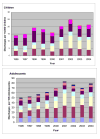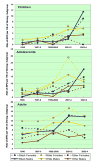Increased rates of bipolar disorder diagnoses among U.S. child, adolescent, and adult inpatients, 1996-2004
- PMID: 17306773
- PMCID: PMC2001259
- DOI: 10.1016/j.biopsych.2006.11.006
Increased rates of bipolar disorder diagnoses among U.S. child, adolescent, and adult inpatients, 1996-2004
Abstract
Background: Volatile, aggressive behavior is the chief complaint that brings children to inpatient psychiatric care. These difficulties are increasingly conceptualized as bipolar disorder (BD). The impact of doing so on clinical diagnoses in clinical care is uncertain.
Methods: We extracted records from the annual National Hospital Discharge Survey (NHDS) for which a psychiatric diagnosis was primary and examined trends in the rates of hospitalization for BD.
Results: Population-adjusted rates of hospital discharges of children with a primary diagnosis of BD increased linearly over survey years. The rate in 1996 was 1.3 per 10,000 U.S. children and climbed to 7.3 per 10,000 U.S. children in 2004. Bipolar disorder related discharges also increased fourfold among adolescents. Adults showed a more modest, though still marked, rise of 56%. Bipolar disorder related hospitalization was more prevalent among female adolescents and adults, while male children had larger risk than female children. Children's BD diagnoses tended not to specify a prevailing mood state, while depression and psychotic features were the most common codes for adults. Black individuals, especially men, had lower rates of BD diagnoses in early survey years, but more recently their rate of BD related hospitalizations has exceeded other NHDS race groups.
Conclusions: Higher rates of inpatient admissions among youth associated with BD may reflect greater appreciation of the importance of affective dysregulation in this patient group or "upcoding" to putatively more severe conditions for reimbursement or administrative reasons. Further study is warranted to examine this shift's causes and implications for treatments and outcomes.
Figures




Comment in
-
Dimensions in the development of bipolar disorder.Biol Psychiatry. 2007 Jul 15;62(2):104-6. doi: 10.1016/j.biopsych.2007.04.035. Biol Psychiatry. 2007. PMID: 17601484 Review. No abstract available.
References
-
- Althoff RR, Faraone SV, Rettew DC, Morley CP, Hudziak JJ. Family, twin, adoption, and molecular genetic studies of juvenile bipolar disorder. Bipolar Disord. 2005;7:598–609. - PubMed
-
- American Psychiatric Association. Diagnostic and Statistical Manual of Mental Disorders. 4. Washington, DC: Author; 1994.
-
- Bickman L, Foster EM, Lambert W. Who gets hospitalized in a continuum of care? J Am Acad Child Adolesc Psychiatry. 1996;35:74–80. - PubMed
Publication types
MeSH terms
Grants and funding
LinkOut - more resources
Full Text Sources
Other Literature Sources
Medical

